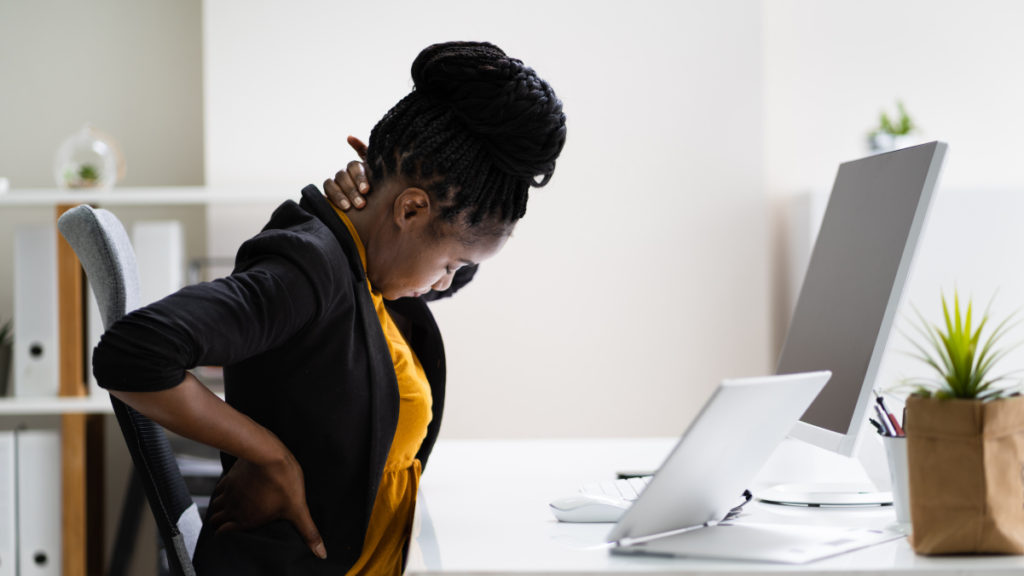As a student or employee, sitting at a desk all day can be a lot of the job. And with that can come the familiar aches and pains of uncomfortable desk chairs, a stiff neck from hunching over the computer, and cramping hands from endless clicking. But what if we told you work doesn’t have to be so troublesome?
What is ergonomics?
According to the International Ergonomics Association, ergonomics (also called human factors), is the scientific discipline concerned with the understanding of interactions among humans and other elements of a system, and the profession that applies theory, principles, data, and methods to design in order to optimize human well-being and overall system performance.
Basically, ergonomics is the study of people in their work environment and the improvement of the objects in their environment to better suit the worker and improve their ability to work. If something is ergonomic, it is created to increase productivity and efficiency while reducing discomfort or chance of injury.
Why do we need ergonomics?
Ergonomics is all about improving your ability to work by focusing on how we interact with our work environment. These improvements help ease issues we would otherwise face, like bad posture and back pain from uncomfortable desk chairs or muscle strain from repetitive neck movements.
As a student or employee, ergonomics can be life-saving. Spending hours hunched over a desk isn’t ideal, but having the tools and know-how to lessen the physical toll can make a huge difference.
Things that should be ergonomic:
Ergonomic Keyboard, Mouse, and Mouse Pad
Frequent, prolonged use of a mouse and keyboard can cause wrist and index finger strain. Repetitive bending of the wrist and index finger while using a computer can make what starts as a small strain into a severe condition. These strains can develop into hand cramps, carpal tunnel syndrome, tendonitis, and trigger finger.
Ergonomic mouse and keyboard options like the trackball mouse and split keyboard are designed to be more comfortable and reduce repetitive movement of the forefinger and wrist. Ergonomic mouse pads are made with wrist rests to reduce wrist movement and provide proper support.
Ergonomic Keyboards:
Ergonomic Mouse Options:
Ergonomic Mouse Pads:
Ergonomic Desk
Eye Level
To achieve an ergonomic monitor height, your computer should be at or slightly below eye level (if you wear glasses with bi-focal or trifocal lenses it should be lower), and your monitor should be about 18 inches from your face. View it from a downward angle of about 15-30 degrees to align with your eyes’ natural straight forward and downcast line of sight.
Height Adjustable Desk
Height adjustable desks are becoming more popular among students and workers for the many health benefits they provide. The option to switch between sitting and standing makes users more energetic, reduces back pain, and may increase their lifespan. Find ergonomic desks on Amazon, IKEA, Home Depot.
Dual Monitor
With a dual monitor set up, your monitors should be kept at the same height. Your primary monitor should be placed in front of you, while the secondary monitor should be kept at about a 30-degree angle to the primary monitor. The primary monitor will be the one you use most, as it is for viewing, while the secondary monitor is for data input. Keep the screens close together and use eye movements rather than head or neck movements to view the screen.
Ergonomic Chairs
Having an ergonomic chair can improve your posture and mitigate back problems caused by desk chairs, and you won’t dread having to sit for long periods.
Ergonomic Chairs and Accessories:
Ergonomic Pillow
Ergonomic pillows support the neck and usually keep your head aligned with your body’s natural position while you sleep. These pillows can also be good for the waking world and can be used as back support and seat cushions to help your posture. Memory foam and other special pillow fillings are often used in ergonomic pillows. Try these ergonomic pillow options:
Sleeping Positions
An ergonomic pillow is only one part of healthy sleep. Your sleeping position at night is just as important as your sitting position throughout the day and any strain you cause your muscles will follow you throughout the day. Neck and back strain from improper sleeping positions can be especially bad if left unaddressed.
Tossing and turning can cause poor sleep quality and may be a sign that something isn’t right with the way you are sleeping. You may toss and turn to get more comfortable or to relieve discomfort. This could mean your sleeping position is not suitable.
Side sleeping is considered the most healthy sleeping position. If you are a side sleeper, drawing your legs up slightly toward your chest and putting a pillow between your legs can alleviate back discomfort and reduce tossing and turning. Avoid putting weight on your arms, as this can cause circulation issues.
When sleeping on your back, place a pillow under your knees to help maintain the normal lower back curvature. This will help prevent back pain this position can cause. You can also place a small rolled towel under the small of the back for more support.
Sleeping on your stomach causes strain to the cervical spine, which can cause nerve compression, muscular imbalance, and muscle pain. If you find it difficult to sleep in another position, place a pillow under your pelvis and lower abdomen. And avoid sleeping without a pillow unless a pillow doesn’t cause back strain for you.
TIP: Check out our post “Top Tips to a Better Sleep in College” for more information on what you can do to sleep better.
Don’t forget to subscribe to our weekly blog so you don’t miss out on more posts like this one! And check out our Adulting Series if you haven’t already for the best tips, tricks, and how-tos of #Adulting.
Be sure to connect with us @ecampusdotcom on Twitter, Instagram, & Facebook for more resources, tips, and some great giveaways! And when it’s time for textbooks, eCampus.com.
